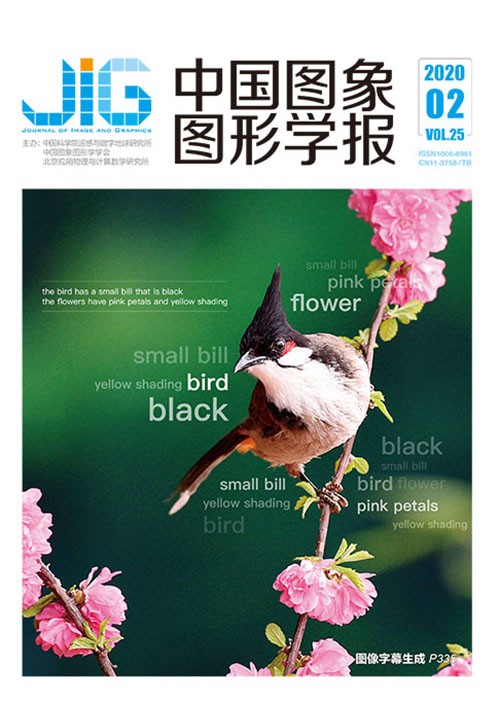
结合多尺度条件生成对抗网络的井下轨道检测
卫星1,2,3, 杨国强1, 李佳1, 陆阳1,2, 石雷1,2(1.合肥工业大学计算机与信息学院, 合肥 230601;2.安全关键工业测控技术教育部工程研究中心, 合肥 230009;3.合肥工业大学智能制造技术研究院, 合肥 230051) 摘 要
目的 传统的轨道检测算法受环境干扰因素大导致检测效率低,基于卷积神经网络(CNN)算法的轨道检测结果缺乏对于对象的细腻、独特刻画且过多依赖可视化后处理技术,因此本文提出一种结合多尺度信息的条件生成对抗网络(CGAN)轨道线检测算法。方法 在生成器网络中采用多粒度结构将生成器分解为全局和局部两个部分;在判别器网络中采用多尺度共享卷积结构,进一步监督生成器的训练;引入蒙特卡罗搜索技术通过对生成器的中间状态进行搜索,并将结果再送入到判别器中进行对比。结果 在井下巷道场景测试集中,本文方法取得了82.43%像素精度和0.621 8的平均交并比,并且对轨道的检测可以达到95.01%的准确率;与现有的语义分割的算法相比,表现出了优越性。结论 本文方法能够有效应用于井下复杂环境,一定程度上解决了传统的图像处理算法和卷积神经网络算法存在的问题,从而有效服务于井下自动驾驶。
关键词
Multiscale information-based conditional generative adversarial nets for downhole track detection
Wei Xing1,2,3, Yang Guoqiang1, Li Jia1, Lu Yang1,2, Shi Lei1,2(1.School of Computer and Information, Hefei University of Technology, Hefei 230601, China;2.Engineering Research Center of Safety Critical Industry Measure and Control Technology, Ministry of Education, Hefei 230009, China;3.Intelligent Manufacturing Institute, Hefei University of Technology, Hefei 230051, China) Abstract
Objective In recent years, the frequent occurrence of large-scale mine accidents has led to many casualties and property losses. The mines' production and transportation should be promoted in the way of intelligence. When moving under the mine, the controller of a locomotive needs track information to detect the presence of pedestrians or obstacles in front of it. Then, the locomotive slows down or stops as soon as an emergency condition appears. Track detection, which uses image processing technology to identify the track area in a video or image and displays the specific position of the track, is a key technology for computer vision to achieve automatic driving downhole. Track detection algorithms based on traditional image processing can be classified into two categories. The first is a feature-based approach, which uses the difference between the edge and surrounding environment to extract the track region and obtains the specific track location in the image. However, this method relies heavily on the underlying features of the image and is easily interfered by the surrounding environment, which brings great challenges to the subsequent work and affects the final detection effect of the track. The second is a model-based strategy, which converts the track detection into a problem of solving the track model parameters and achieves the fitting of the track based on its shape in the local range. The track model often cannot adapt to multiple scenarios, and the approach lacks robustness and flexibility. Track detection results based on the convolutional neural network algorithm lack a detailed, unique characterization of the object and rely heavily on visual post-processing techniques. Therefore, we propose conditional generative adversarial net, a track detection algorithm combining multiscale information. Method First, the multigranularity structure is used to decompose it into global and local parts in the generator network. The global part is responsible for low-resolution image generation, and the local part will combine with the global part to generate high-resolution images. Second, the multiscale shared convolution structure is adopted in the discriminator network. The primary features of the real and synthesized samples are extracted by sharing the convolution layer, the corresponding feature map is obtained, and different samples are sent to the multiscale discriminator to supervise the training of the generator further. Finally, the Monte Carlo search technique is introduced to search the intermediate state of the generator, and the result is sent to the discriminator for comparison. Result The proposed algorithm achieves an average pixel accuracy of 82.43% and a mean intersection over-union of 0.621 8. Moreover, the accuracy of detecting the track can reach 95.01%. For many different underground scenes, the track test results show good performance and superiority compared with the existing semantic segmentation algorithms. Conclusion The proposed algorithm can be effectively applied to the complex underground environment and resolves the dilemma of algorithms existing in traditional image processing and convolutional neural network, thus effectively serving underground automatic driving. The algorithm has the following virtues. First, it generates high-resolution images by generative adversarial nets and addresses unstable training in generating edge features of high-resolution images. Second, the multitask learning mechanism is further conducive to discriminator identification, thereby effectively monitoring the results generated by the generator. Finally, the Monte Carlo search strategy is used to search the intermediate state of the generator, which is then feed it into the discriminator, thereby strengthening the constraints of the generator and enhancing the quality of the generated image. Experimental results show that our algorithm can achieve satisfactory results. In the future, we will focus on overcoming the issue of track line prediction under occlusion, expanding the datasets, and strengthening the speed, robustness, and practicality of the algorithm.
Keywords
track detection conditional generative adversarial nets(CGAN) multi-scale information Monte Carlo search automatic driving downhole
|



 中国图象图形学报 │ 京ICP备05080539号-4 │ 本系统由
中国图象图形学报 │ 京ICP备05080539号-4 │ 本系统由